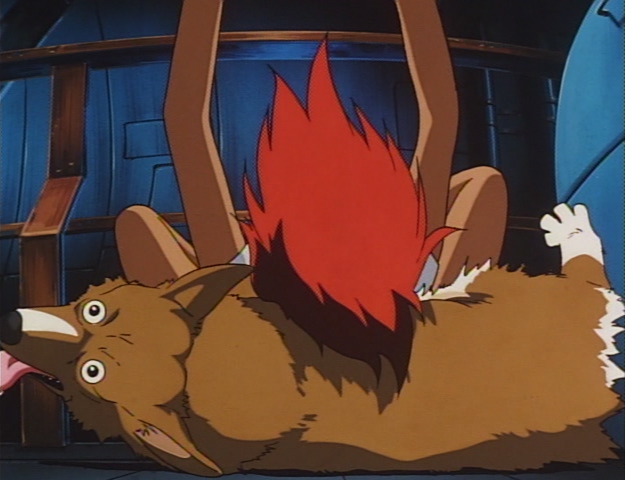
I couldn't find a person with a pet on their head this time, but I did find someone with their head on a pet. Close enough.
12 and 13) And then, hot on the heels of that little orgasm of goofyness, we find Jupiter Jazz parts 1 and 2, which are possibly the moodiest and darkest episodes yet. Not “Dark!” in a winking, half-parodic way, like “Sympathy for the Devil” or “Ballad for Fallen Angels,” but honestly melancholy to the point of depression. It telegraphs its seriousness in a couple of different ways… It’s a double-long episode, which, like a double-disc album or a double-wide trailer, indicates a certain gravity of purpose. It also marks the return of Vicious, the villain from “Ballad for Fallen Angels” and Spike’s flashbacks in episodes 1 and 6. I’ve gotta say, Vicious didn’t do a lot for me at first. I understand that he fits a certain character mold that has proved durable and popular, but… man. Whenever he rears his ugly immaculately-coiffed head, you can almost feel the writers of the show poking you in the ribs with their elbow and whispering “Hey, isn’t this episode very serious???” It feels forced and unnecessary: his tortured relationship with Spike would work a lot better for me if he wasn’t such a caricature. But I dunno, most Cowboy Bebop characters rub me the wrong way at first. Maybe if there were more Vicious episodes, I’d get used to having him around. He improves in this one, a bit, right at the end.
Another annoying writing tic that shows up in this episode is Faye randomly turning into a psychotic hose-beast. Somewhere in the gap between the last episode and this one (presumably after everyone comes back from the dead), Faye decided to leave the ship. No wait, she decided to sabatoge the BeBop, steal all the money from the safe, and run off in the dead of night. This feels… unlikely. And while we actually learn in the second part of the episode that she did have some reasons that, if not good, are at least vaguely believable, there is nothing believable about Spike and Jet deciding to let her back on the ship at the end. I mean, I can see what the writers are trying to do with that: “Home is the place where, when you have to go there, they have to take you in… something you somehow haven’t to deserve,” says Robert Frost. So maybe it works. Maaaaaybe. But it’s a stretch.
At least Faye running off to join the circus provides a convenient impetus for the action of the plot. While searching for her, ostensibly to recover the money, Spike runs across some information about his mysterious lost love, Julia. But the specifics of this are just incomprehensibly dumb. Ed just goes searching for Faye in cyberspace, and comes back with a name, “Julia,” and a location, Callisto. The only way this could have worked is if Ed tried to search for Faye simply by typing the word “Woman” into google… and furthermore, it means that the only other woman mentioned anywhere on the entire internet just happens to be Spike’s ex-girlfriend. Trust me, I’ve been on the internet. It doesn’t work that way. (And if you’re planning on trying this yourself, you may want to turn on the ol’ safe-search. ) Spike’s reaction is even more idiotic, because he immediately drops everything and goes tearing off to Callisto. Jet even calls him on this nonsense: “It’s a common woman’s name!” But apparently not, because while Julia doesn’t actually appear in this episode, she was on Callisto not long ago. And to fill out the unlikely-coincidence Quinella that the writers have been working on here, Faye actually did run to Callisto after all.
AAAAARGH!
Okay, I needed to get that out. But let me just say that in most other respects, this episode is a smashing success. Glaring as the plot holes are, you don’t really notice them when you’re watching (or at least I didn’t).
So like I was saying, Spike goes tearing off. As he’s climbing into his ship, he and Jet have this deeply weird, deeply bitchy argument where Jet tries to cajole and threaten him into staying, finishing up with the always-reliable “Well if you walk out now, don’t expect me to let you back in!” Spike, for his part, just says a bunch of really callous and hurtful stuff as if he’s not just trying to burn his bridges, but also sow the river with salt so that no bridge will ever grow there again, and I think that I lost track of this metaphor somewhere along the way, but you get the picture.
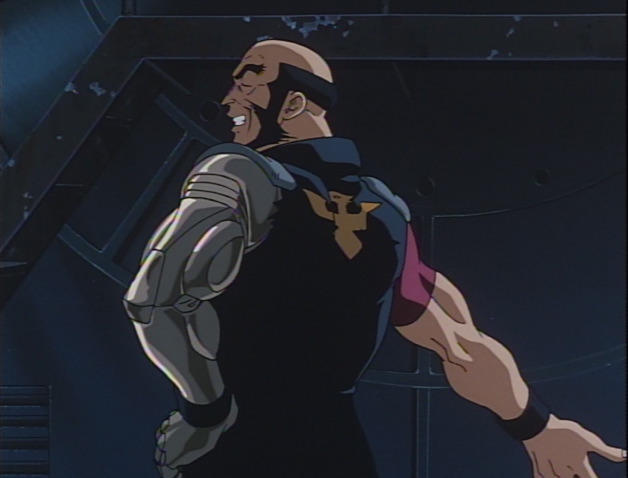
Also, during the fight, Jet does this weird little sashaying dance. Not because he's making fun of Spike or anything - he's just punctuating his argument with (really weird) broad arm gestures. I wonder if there's some Japanese cultural reference that I'm not getting here.
The way this fight is written and performed is very jarring. It has to be the first time we’ve ever seen Jet really lose his temper. And it feels like nothing so much as a lover’s quarrel, which is not a vibe that we’ve gotten from these two so far. But maybe that’s intentional, because this is definitely the “Cowboy Bebop plays with alternative sexuality” episode. In a big way.
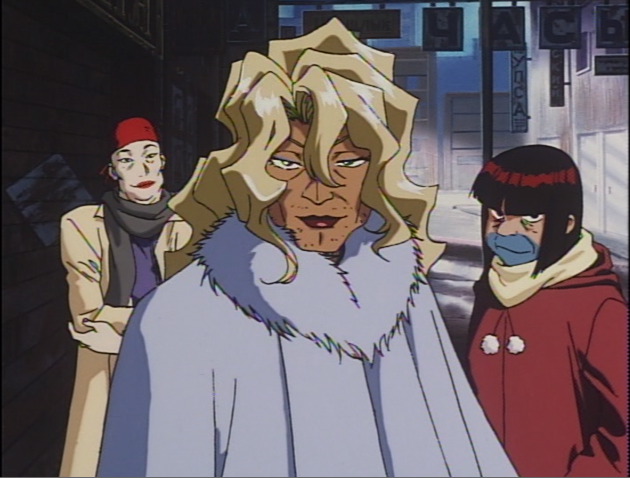
On Callisto, Faye is holed up in a bar getting tanked, apparently hoping that some dudes will try to attack her so that she can work off some steam by kicking the crap out of them. At the bar she meets Gren, a sax player, and briefly considers working off some steam with him the other way (if you know what I mean) before learning that he doesn’t care for the ladies (if you know what I mean about that too), and they just get drunk together instead. Meanwhile, Spike goes, like, absolutely King-Kong nuts on some thugs who try to rob him. Incidentally, you know how I said a few posts back that the first episode of Cowboy Bebop makes it look like it’s going to be all about kung fu? This is, I think, the first episode since the pilot to live up to that promise. Theoretically the brawl is motivated by the fact that the thugs mistake him for Vicious – Spike was asking about Julia, and it turns out that the reason her name was floating around the internet is that Vicious is using it as a password for a huge drug deal that he’s running – and being compared to Vicious makes Spike really, really angry.
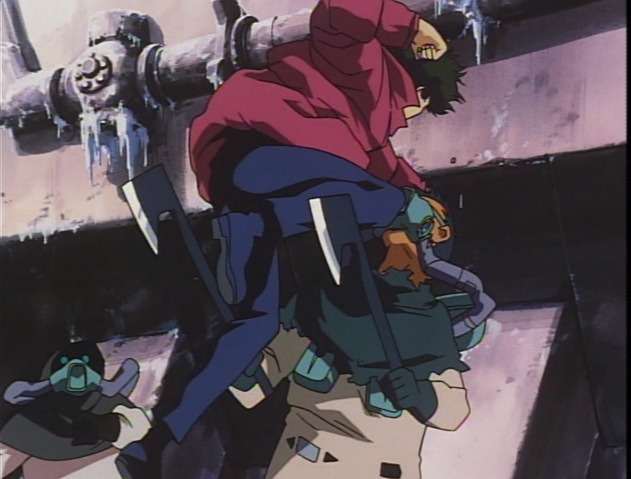
We Axe Gang never mis - aghfpk!
My inner cynic suggests that the brawl is motivated by the two-part special episode having a slightly larger animation budget. But no matter. Faye eventually pours herself out of the bar and goes wandering around the streets looking for trouble, which she finds. Actually, she find the exact same group of thugs that Spike just humiliated. If they think that they can take their frustration out on her, they’re sorely – OH MY GOD WHAT HAPPENED TO HER LEG??!!
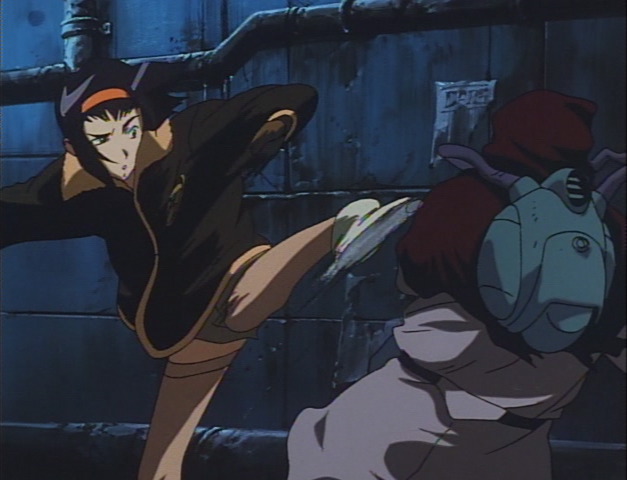
Okay, so actually distortions like this on a single frame are a time-honored way for animators to convey the extreme speed or forcefullness of an action, but that doesn’t make it look any less horribly wrong when I unfairly freeze it as a still image. Anyway, we never get to find out whether they’d have been able to take her in a fight, because as soon as she flattens that one dude, Gren pops out of nowhere, clobbers the head thug with his sax case, and pulls Faye away to safety by her wrist.
Back at his apartment, they drink vodka and hot water (which actually sounds like a pretty great drink for a brutally cold day), and shoot the breeze. Faye notices a music box – now where have we seen one of those before? – that Gren is oddly defensive about. Then he goes off to take a shower, and she notices an old picture of Gren wearing a military uniform… and standing next to Vicious. (Man, these coincidences are just piling up.) Meanwhile, Spike and Vicious come face to face on a random frozen street corner. Spike, who has a pistol, would seem to be at a tactical advantage, but Vicious has an underling with him, Lin, that Spike has some kind of past friendship with, and is therefore unwilling to shoot. Back in Gren’s apartment, Faye pulls her gun and marches into the bathroom to confront Gren for… for what, having ever known Vicious? Who Faye, although she certainly has no reason to be fond of him – he did hold her hostage that one time – basically doesn’t know? Whatever the reason, she barges into the shower, only to learn, in a NSFW sequence, that Gren is actually a hermaphrodite. Or a pre-op transsexual. Or something. Let’s just call him differently gendered and leave it at that, since it’s by no means clear what he identifies as. In any case, Faye’s reaction is comically disproportionate. I mean, we’re given to understand that she has seen a thing or two in her day, and she is not generally a woman given to freezing up. But plot convenience demands that she not actually interrogate Gren at gunpoint at this time, so she freezes up and he takes the gun away. My best explanation for this is that she must be falling down drunk: she was already pretty potted at the bar, and by this point she seems to have consumed the better part of half a bottle of Gren’s vodka. But before that situation can resolve itself, we cut back to Spike, and learn that although he was unwilling to shoot his old buddy Lin, Lin was under no such compunction. Blam. Cue the soaring saxophone solo, and the end credits for part one of the episode.
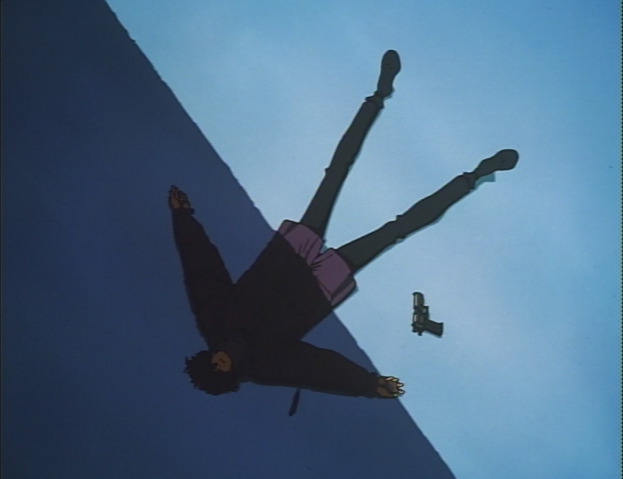
Spike Spiegel Deaths So Far:
1: Gunned down in a hail of bullets by persons unknown in flashback at start of “Asteroid Blues.”
2: Thrown off of an exploding cathedral by Vicious at the end of “Ballad for Fallen Angels.”
3: Poisoned by mutant Lobster at the end of “Toys in the Attic.”
4: Shot dead by Lin halfway through “Jupiter Jazz.”
Just so we’re counting.
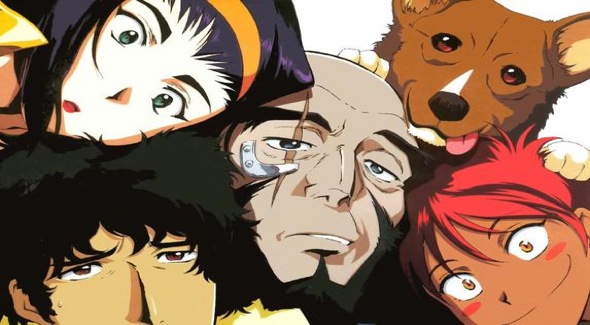
Ed’s 4th wall-breaking and her dubious lesson in Toys in the Attic is a lot more revealing to her worldview: she’s completely disconnected from reality. There are no consequences in Ed’s mind.
There’s a lot of assumption on the writer’s part for Jupiter Jazz. They assume we have figured out what makes these characters tick and I’ll give you my thoughts on the matter
Being bounty hunters, Ed would be skimming underground sites and bounty hunter websites that deal in rumors and criminal sightings. With Julia’s name coming up (despite being a common name), Spike would still react to it because of where it came up: the criminal underbelly of the solar system. That makes, at least in my opinion, Jet and Spike’s argument all the more poignant. Jet assumes that Spike is going chase after his past. The last time he did that, we got Spike the Mummy and Jet’s willing to bet that Spike will be coming back in a body bag. However, I can’t explain how Faye ended up in the same moon as the Julia rumor (and ultimately Spike) other than plot convience. Nor can I explain why they just let Faye back on the ship despite how much she screwed them.
Faye’s actions inside Gren’s apartment are also pretty explainable if you follow Miss Valentine’s modus operandi for (most) of the series: money. Gren was/is close friends with Vicious, as evidenced by the pictures Gren has of the two in uniform. Vicious is the leader of the Red Dragons, a premiere organized crime syndicate. Gren’s in the shower alone, unarmed and possibly with a nice bounty on his head. I believe I can see the dollar signs in Faye’s eyes. She is flirty with Gren and shows some attraction to him but now it’s business. I imagine all the alcohol she’s consumed in the last 12 hours also influenced her decision making.
Faye’s reaction to the reveal of Gren’s intersexed condition is a well done. She was attracted to what she was classify as a woman. She isn’t exactly pleased with this revelation and doesn’t really know how to react to it (I imagine the booze isn’t helping either). Once she finds out Gren’s past, her prior plan doesn’t really work as Gren doesn’t have a bounty and there’s no guarantee that Faye could even get to Vicious now. I’m also sure she’s sobering up and her plan isn’t as great as she first imagined it.
having read all 4 of your posts, i now feel qualified to comment. i would have written some comments on the other articles, but apparently i am too late. you make some really interesting points and comparisons, but you seem to ignore one critical aspect of cowboy bebep. which is this: it is anime. i don’t know if this was touched on in the past, or assumed, or deliberately ignored, but some of your observations and comments could be answered by the fact that this series is a product of a foreign pop culture. and there are certain aspects of that culture that explain some peculiarities of the series, most notably, the animation. the long panning shots of static backgrounds and images are a staple of anime, not because of artistic license, but because they save money. the same could be said about weird character movements, strange visuals such as the fruit flying over ein in episode 2, and the reuse of establishing shots like the bebop pulling into a warp gate, which i know you haven’t mentioned. and while i know the music was innovative for an anime series at the time, the choices aren’t necessarily as deliberate as you might think. Yoko Kanno composed hundreds of songs and themes for the show before the animation went into production and Watanabe or whoever the shot caller was picked and chose what to use for any particular scene or episode. that is why there are 5(?) soundtracks for the show that have a ton of songs that you may not recognize or possibly have never heard. no one knew how popular cowboy bebop was going to be until it started to be popular, after production had already ended on the core series, and so it was produced in the japanese anime tradition: haphazardly. in fact, if i remember correctly, it never aired in its entirety in japan until after it started to gain popularity in america. at the time, it was really just Watanabe’s low budget love letter to american culture.
maybe your analysis of the series is purposefully ignorant of the intentions of the creators of the series, i don’t know. but basically what i’m getting at is this: like all anime, it has to be viewed through the lens of our cultural differences and translation problems before it really starts to make sense. there are some points where you touched on that, like jet’s weird arm gestures and the translation problems at the end of episode 10, but i feel that you are taking too small a scope on its impact on the entire series.
side note: i am endlessly amused by your nod to the tick. and here i thought i was the only one.
@marmls2m I don’t think that’s a valid criticism of Mr. Stokes’ analysis. Yes, something is lost in the translation and there is a culture gap between American and Japanese audiences. It does lead to some references and direction that leaves us curious (like the character design influences and the fruit flying), it does not immediately exclude us from understanding the themes and the narrative value of the show. The show stands on its own and can freely be criticized by the masses regardless of whether we understand every single minituae of the show.
You also gloss over the fact that Cowboy Bebop was not show in its entirety in both Japan and the US until it was very popular as it crossed Japanese and US cultural taboos. The first episode wasn’t cleared for air in Japan as it featured prominent drug use. The US had 2 episodes cut (episodes 6 and 8?) because it featured violence against children and a plane hijacking shortly after 9/11. There’s also an episode that featured the WTC but I can’t remember if they trimmed the scene out or if they cut the whole episode during the first few runs.
cowboy funk. cut out of its run on adult swim either the first or second time, i cant remember.
@marmls2m
Good points, but also, restrictions breed creativity. If circumstances, budget or genre force you to use a certain technique or make something a certain way, it’s better to make it work on your own terms than to just let it happen.
For example, _Paranormal Activity_ is the way that it is because it was shot on a super-low budget. But the aesthetic choices are also deliberate and have other purposes.
@Riderlon –
Yeah, to a certain degree I’m being uncharitable about the plot holes just because it makes for a funnier article. And you’re absolutely right about *why* Jet gets in an argument with Spike (although it doesn’t make the way their argument is carried out any less strange). I disagree with you about Faye’s motivation for drawing down on Gren though – I don’t think it’s supposed to be money, I think she wants revenge on Vicious for Spike or for herself.
@marmlst2m – “maybe your analysis of the series is purposefully ignorant of the intentions of the creators” Yeah, that’s the one. I always try to avoid learning anything about the creator’s artistic vision until I’ve drawn my own conclusions about the work itself. Especially when I’m dealing with something like film or TV, where pinning down one creator is often borderline impossible. I don’t mean to say that this is the “right” way to analyze a show, but for me doing it the other way is kind of paralyzing.
As for the music “not being deliberate,” while I freely acknowledge that I have no idea who assigned which track to play under which scene, someone made the choice. I usually assign that agency to the composer for the sake of convenience, but even if it turns out to have been left up to some lowly production intern, I’m sure that whoever it was said “Wow, placing the music! Here’s my chance to shine!” and did the best job they could do.
Your criticism that I should approach this with more of a background in anime is harder for me to answer, because I probably should. There’s always room for multiple perspectives, as Riderlon points out, and I like to think that includes the perspective of a genre neophyte like myself. But it IS usually better to be able to put the work in context with its genre. Let me ask you, (and Riderlon, I’d love you to weigh in on this as well, because from the earlier comment threads you seemed to be well-informed): what aspects of Cowboy Bebop are generically required? That is, are there some parts of the show that are so common in anime – specifically action/sci-fi anime – that they don’t even bear commenting on? I can think of one example right off the top of my head (Spike’s green hair), but I’m sure there are others that I’m not seeing.
(Keep it spoiler free please, though – I still want to approach the rest of the show without preconceived notions.)
just off the top of my head, i would say translation is a really big issue. like almost all anime, the english voice actors were really hamming it up and pretty much butchered most of the dialogue. my favorite example of this is in episode 3, honky tonk woman, in the exchange between faye and spike at the blackjack table.
(i am going completely from memory here)
english subtitles:
“i am not nimble, nor am i lucky”
“what are you?”
“generous”
english sound track:
“i’m not skillfull and i’m not really lucky either”
“what are you then?”
“well, i seem to be very generous”
what is a simple, graceful, elegant, and well written exchange becomes a pop up book level display of the awful translation job. that is not to say the subtitles are totally perfect either. let me just say that my japanese friend had much more criticism for the english dialogue then i did.
the second thing i can think of right now is fan service, which explains faye’s ridiculous outfit and the amount of coverage seemingly dedicated till faye’s boobs (just wait till you see the movie). fan service is pretty much an inescapable aspect of any anime aimed at an audience over grade school age. while there are some shows that do avoid fan service, like full metal alchemist, they often fall into other trappings of anime, like silly rage attacks and deliberatly poor animation.
i would also like to point out that i feel ed’s personality to be pretty irrelevent to the series, as he/she does have a tendancy to break the 4th wall, and no one in the show really pays that much attention to her insanity. it is just my personal opinion that ed was just kind of shoved into the show with little regard for how it would affect the greater story or their other, better fleshed out characters. ed seems to be there only for comic relief, and only, it seems, in moments and episodes where it has no effect on the story or general mood.
@stokes I’m glad you consider me an expert. I think I have too much time and disposable income.
Cowboy Bebop hits a few things that you as a self processed neophyte would probably miss: Spike, Jet and Faye’s character designs are homages to the cast of Lupin III, which is a series that’s been (essentially) running since the 70s. The hair color thing is just to make characters more memorable and diversify the cast. I’m trying to think of some specific examples but it’s been ages since I sat down and watched Cowboy Bebop.
@marmls2m You make it sound as if the English translators either go out of their way to ruin dialogue or that they’re totally incompetent at their jobs. Citing the example you use as a way the English dialogue was inferior. They have to match the dialogue to the lip movements. The exchange between Spike and Faye still conveys the same information and the code talk (from Faye’s perspective)/flirty tone (Spike’s perspective) but loses a little bit of that “elegance” as you put it. You also seem to fail to realize that the Japanese companies have a pretty large part in the translation and voice selection process. The English scripts and the cuts of the dialogue will not go anywhere until the Japanese studio (Bandai, in this case) approves it.
The problem of translation is not specific to anime, of course, but Cowboy Bebop is an interesting case. Most of the differences between the dub and the subtitles are like the one marmls2m points out, where the dubbed version is slicker, more verbose, more conversational, etc. And I agree that this is annoying. However, very rarely, there will be a really substantive change. And in these cases, I sometimes find myself preferring the dub. For instance, there’s a throwaway scene in one episode (Ganymede Elegy, I think), where Faye spends a little time working on her tan. Ed asks her why she’s doing it. Here’s her reply, according to the subtitles:
“Beautiful skin requires constant effort that seems futile,”
and the dub:
“Beautiful skin requires constant effort that is ultimately futile.” [emphasis mine]
Just a small change, but there’s a world of difference between them. The dubbed version presents a character that is complex, ironic but resigned, vain but self-aware, and generally interesting</em. The subbed version comes off as vain and conceited, and that's about it.
Now, I generally assume that the subtitles are closer to the original Japanese, per lectio difficilior. But does that make them better, necessarily? Or should translators feel free to improve the original whenever they get the chance? Obviously the problem with this second tactic is that a lot of the improvements end up being “improvements” instead. But there are some cases where they actually are better… and I find that these put me in an uncomfortable position. I don’t know how to judge them, honestly.
>.
(Better late than never.)
Not that anyone cares, but, although I’m usually a big proponent of subtitles, where Bebop is concerned, I prefer the dub, primarily for the reasons Stokes outlined above. (Although maybe it’s just ’cause I’m sick of hearing Megumi Hayashibara’s voice, I don’t know.)
anime dubs have been getting much better lately, with the rise of anime’s popularity in the us. pre-2000 no one really gave a crap about the english dub, which explains how the atrocious dub of envangelion happened.
I find your analysis interesting, yet I believe it fails in its mention of the LGBT part of the episode. Gren never changed his “gender” and it wasn’t inflicted upon him, if anything was inflicted upon Gren, it was the gynecomastia that he suffers from. That is all. If anything, I think the portrayal of LGBT characters is interesting in this episode as Gren casually admits that he is homosexual and it is not played in a gag in a 1998 anime. I guess my comment is a bit too late, but still.
For Toys in the attic, I always saw it as a dream that Ed was having. (Which would explain the ridiculousness of the episode) Towards the beginning of the episode she’s asleep and you hear her mutter, “I can’t eat anymore” At the end she says the same thing.